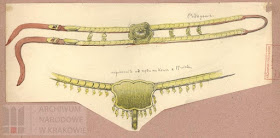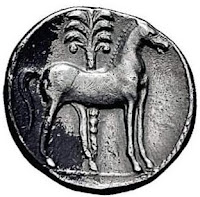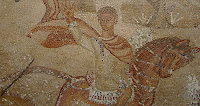Equestrian Polish, Eurasian and the Americas history and horsemanship - from Bronze Age to circa1939AD. Historical equestrian art, my own artwork; reconstructions, and some traditional art media and digital artwork-related topics. All rights reserved unless permitted by 'Dariusz caballeros' aka DarioTW, copyleft or fair use.
Saturday, February 23, 2013
Drawings at Archiwum Narodowe w Krakowie
Salve,
Archiwum Narodowe w Krakowie (The National Archive in Krakow) has been digitizing their collections, and many of these drawings showing historical objects are of great interest to us, aficionados of horse, horse tack and cavaliers associated with the historic horsemanship.
These coloured, watercolor and pencil, drawings showing horse tack were done by a Polish painter Walery Eljasz Radzikowski, prolific illustrator and painter of XIX century partitioned Poland. Here, samples of his work - paintings and illustration etc
.
.
First, the saddles . Here a saddle with a matching pistol holster
For comparison a photo of an actual XVII century Polish saddle from the Lwów Museum Przemyslowe (pre-1939)
Saddle of grand hetman Stanisław Jan Jabłonowski - one image from the digitalized Cracow Archive drawing and one from a magazine print from XIX century, both by Eliasz-Radzikowski. Note the precious stones, gilded metal parts, perhaps gold thread brocade, wide stirrups,
here we have hetman's entire horse tack suit - the bridle with its exquisite metal and precious stone work, while the curb-bit is of the so called Moorish type aka Morisco type
Horse tack of Jan III Sobieski
metal net -part of the bridle and a horse tug - this particular style of horse head adornment can be seen in XVI-XVIII centuries art showing Ottoman Turkish and Polish-Hungarian horses and their tack.
breastplate and crouper - metal 'scales' most likely gilded
Variety of horse tack: detail of the breastplate and crouper - imagine how it shone and sparkled with the sunlight, being gilded metal
bridle (not throatlatch); breastplate and crouper -details
crouper and a halzbant (hanging from its strap - part of the bridle)
details of a bridle, entire crouper, detail of a breastplate
Curb-bits - details
*
many thanks to Archiwum Narodowe w Krakowie for allowing me to share with you these great records of historic Polish (albeit Tatar and Turkish influenced) horse tack.
Friday, February 22, 2013
Roelandt Savery's horses
Salve,
today we will turn to the images of horses painted by messer Roelandt Savery, Flemish-Dutch painter active in Europe during the first half of XVII century, and who was a painter in the Flemish tradition of Peter Breughel the elder and ''his school'' and perhaps a disciple, clearly influenced by, of another famous Dutch artist Gillis van Coninxloo.
Here a detail of van Coninxloo's painting, Landscapes with a scene of life of St. Paul, showing riders and their horses, including one that is mounted on a dun horse and who looks a lot like the Polish, Hungarian or Croatian light cavalryman, especially his arms and costume - short blue żupan, and a sabre perhaps.
Messer Savery was a prolific painter, who achieved fame, wealth and prestige in the Dutch Republic and an apparent lover of nature visible through his landscape paintings. Nowadays he is still know because of his drawings and paintings of the extinct dodo bird.
However, dodo is just a tiny part of messer Savery's legacy, as he was a remarkable painter of horses and historical subjects, especially since he lived through the the Dutch-Spanish Wars and the Thirty Years War.
First the horses, often amongst other animals, showing Savery's mastery of the animal form:
here, perhaps a Spanish or Spanish-influenced stallion
.
. two Spanish stallions
. a dapple stallion - a beautiful example of a Baroque horse, Spanish or Spanish influenced
.
.
Historicla subjects:
Sacking of town - image of The Thirty Years War - clearly painted in the tradition of Breughel the elder
Finally, the Polish or Hungarian riders, showing both light and heavy, winged hussar, cavalrymen - supperb rendering of weapons, armour, and costume details
.
ps
* most images come from wikipedia
Wednesday, February 20, 2013
Numidian/Libyan horse - ancient writers and equine art
Salve,
let us stay with the coins of the
Classical Antiquity and turn to the subject of the Numidian/Libyan
horse in the Greek and Roman world for this horse was one of the most famous horse of the Graeco-Roman world .
Libyan horse from a Carthaginian coin:
Various Numidian rulers included horses
on their coins
Diodorus Siculus,
in his Bibliotheca Historica, book XVII (from penelope.uchicago.edu or LacusCurtius), wrote about Alexander, the hero-king of Macedon and
soon Persia:
''Having settled the affairs of Egypt,
Alexander went off to the Temple of Ammon, where he wished to consult
the oracle of the god. When he had advanced half way along the coast,
he was met by envoys from the people of Cyrenê who brought him a
crown and magnificent figures, among which were three hundred
[war] chargers and five handsome four-horse chariots. He received the
envoys cordially and made a treaty of friendship and alliance with
them''
William Ridgeway wrote, quoting various ancient writers, in his book on The origin and influence of the Thoroughbred horse", page 253 :
''The islanders from Thera, who planted Cyrene, were not slow in fulfilling the prophecy of Medea that " instead of short- finned dolphins they should take to themselves fleet mares, and reins instead of oars should they ply, and speed the whirlwind- footed car," for Cyrene soon became famous as "the city of fair steeds and goodly chariots." Pindar glorified her king, Arcesilas, for his victories in the chariot-race, and later her native poet, Callimachus, sang of his " home famed for her steeds
Numidians on the Trajan Column:
..
Horse from a Roman Mosaic (present Tunisia)
..
Strabo, in ''Geography'' book XVII,
wrote on Numidian/Libyan Horse and the various tribes that rode or
used horses in Numidia/Lubia (From LacusCurtius):
''Although the most of the country inhabited by the Maurusians is so
fertile, yet even to this time most of the people persist in living a
nomadic life. But nevertheless they beautify their appearance by
braiding their hair, growing beards, wearing golden ornaments, and
also by cleaning their teeth and paring their nails. And only rarely
can you see them touch one another in walking, for fear that the
adornment of their hair may not remain intact. Their horsemen any
mostly with a javelin, using bridles made of rush, and riding
bareback; but they also carry daggers. The foot-soldiers hold before
them as shields the skins of elephants, and clothe themselves with
the skins of lions, leopards, and bears, and sleep in them. I might
almost say that these people, and the Masaesylians, who live next
after them, and the Libyans in general, dress alike and are similar
in all other respects, using horses that are small but swift, and so
ready to obey that they are governed with a small rod. The horses
wear collars made of wood [tree wool, perhaps cotton] or of hair, to which the rein is fastened,
though some follow even without being led, like dogs. These people
have small shields made of raw-hide, small spears with broad heads,
wear ungirded tunics with wide borders, and, as I have said, use
skins as mantles and shields. The Pharusians and Nigretes who live
above these people near the western Aethiopians also use bows, like
the Aethiopians; and they also use scythe-bearing chariots. The
Pharusians mingle only rarely even with the Maurusians when passing
through the desert since they carry skins of water fastened beneath
the bellies of their horses...'
Horses and riders from Roman mosaic from Libya
.
*
Roman writer of III century A.D. From
Carthago, Nemesianus (again from LacusCurtius ), wrote a poem on
hunting (Cynegetica) where he described, amongst others, the
Numidian/Libyan horses :
''..you may select the
courser sent by Mauretania (if he be a stout descendant of good
stock), or the horse which the dusky Mazax tribesman[Numidian] has
reared in desert fields and taught to undergo ceaseless toil. No need
to repine at their ugly head and ill-shapen belly, or at their lack
of bridles, or because both breeds have the temper of freedom, or
because the neck lashes the sloping shoulders with its mane. For he
is an easy horse to guide, plies obediently under the control of a
limber switch: its strokes are the orders for speed, its strokes are
as bridles too. Nay, once launched across the spacious levels of the
plain, with blood stirred, the steeds win fresh strength in the race,
leaving by degrees their eager comrades behind. Even so, on the
outburst of the winds across the blue waters of Nereus, when Thracian
Boreas has uprisen o'er his cavern and with shrill howling dismayed
the dreary waves, all the blasts on the troubled deep give way to
him: himself aglow mid foaming din, above the billows he o'ertops
them in mastery manifest upon the sea: the whole band of the Nereids
is mazed in wonderment as he passes over their watery domains.Nemesianus gives quite detailed description of the preparation of a hunting horse, with some remarks on their long lasting vigour and longevity if properly cared for :
''These horses are slow to attain confidence in prolonged running; also, theirs is youthful vigour even in age that has served its time. For no quality which has bloomed full at its due period suffers collapse in spirit ere physical powers fail. In the fresh spring-time, then, feed the coursers on soft mash, and, lancing a vein, watch old-standing ailments flow out with the ooze of the tainted blood. Soon strength returns joyously to their gallant hearts, moulding the sleek limbs with strength diffused: soon a better blood runs warm in their veins, and they wish for long stretches of road, and to make the broad plain vanish in their career. Next, when summer has hardened the ripening stalks and, scorching the juicy blades, has dried all the moisture for harvest and joined corn-ears [caveat! -not American Maize] to stems, then be sure to furnish barley and light chaff: moreover, there must be care to winnow the produce free from dust, and to run the hands over the horses' muscles, so that the courser may enjoy being patted and relax his body in pleasure and quickly pass the nourishing juices throughout his frame.''
*
another Roman writer Claudius Aelianus aka Aelian wrote, in Natura Animalium, about the Numidian/Libyan Horse :
''De equo Libyco Libyas talia narrare audio: Eos quidem equorum
velocissimos esse, nullo vero laboris sensu affici; graciles quoque nec
corpulentos, et idoneos ad sustinendam negligentiam dominorum; qui
nullam curam iis adhibent, neque eos, postquam labore fatigati fuerint,
strigile perfricant, nec eis volutabra conficiunt, nec ungulas purgant, nec jubam pectunt, nec capronas implicant, neque fessos lavant;
sed simulatque constitutum iter confecerint, ex equis desilientes
eosdem ad pastiones dimittunt. Ipsi Libyes etiam graciles sunt, et
squalore sordidi hujuscemodi equis etiam vehuntur. Medi autem luxuriae
dediti sunt, atque ejuscemodi illorum equi; quos magnitudine, specie
corporis, et ornatu, ac exteriore cultu atque deliciis una cum dominis
delectari diceres; sentire videntur magnitudinem et pulchritudinem suam itemque se magnifice esse exornatos.'' (translated from Greek to Latin on LacusCurtius).
*
Finally, the Numidan prince is the subject of the famous Bande
Dessinée (French-Belgian comics) series titled 'Jugurtha,'
with awesome horse drawings by two great, but unfortunately deceased,
artists Moebius and Franz Drappier
*
ps most images are from wikipedia
Thursday, February 7, 2013
Ancient horse from coins
Salve,
today is Tłusty czwartek (Fat Thursday) and our Polish folklore associates this day with eating pączki and other delicious sweets; so enjoy them wherever you can find a Polish bakery :)
Good traditions aside, I have been browsing the web looking for the ancient coins and other Hellenic and Roman art images showing Dioskouroi riding horses and holding palm branches, and I cam across some very interesting coins from the ancient Greeks sphere of influence, i..e., Mediterranean Basin. Why are they interesting? Well, because they show different types of horses.
Please note that I do not own any of these images nor have any right to them - they came from this website Ancient Coin search Info
I am showing them to simply share these interesting depictions of horses of the ancient Hellenic world.
Coins from V to III century B.C. - let's the images speak for themselves . Note that Ann Hyland has written on these horses in her book Equus, The Horse in the Roman World.
..
circa 260 from Carthage - a Numidian stallion?
..
Tarentine, Magna Graecia (Italy) - Osprey has a book on the Tarentine horsemen, we need one on the Numidian horsemen
..
..
..
Macedon - Thessalian, Thracian, perhaps steppe influenced horses, eg king Philip II, father of Alexander, brought from his wars (340s B.C.) against the Thracians and Scythians thousands of horses as war spoils - so tell us the ancient historians, eg Quintus Curtius Ruffus or Arrian etc.
Paeonia (Greece)
..
Thrace - Thracian horse, note the famous mares of Greek mythology or Rhesus of Thrace horses
..
Thessaly - a Thessalian horse
..
..
..
Caria, Achaemenid satrapy in Asia Minor - Nisean horse
..
today is Tłusty czwartek (Fat Thursday) and our Polish folklore associates this day with eating pączki and other delicious sweets; so enjoy them wherever you can find a Polish bakery :)
Good traditions aside, I have been browsing the web looking for the ancient coins and other Hellenic and Roman art images showing Dioskouroi riding horses and holding palm branches, and I cam across some very interesting coins from the ancient Greeks sphere of influence, i..e., Mediterranean Basin. Why are they interesting? Well, because they show different types of horses.
Please note that I do not own any of these images nor have any right to them - they came from this website Ancient Coin search Info
I am showing them to simply share these interesting depictions of horses of the ancient Hellenic world.
Coins from V to III century B.C. - let's the images speak for themselves . Note that Ann Hyland has written on these horses in her book Equus, The Horse in the Roman World.
..
circa 260 from Carthage - a Numidian stallion?
..
Tarentine, Magna Graecia (Italy) - Osprey has a book on the Tarentine horsemen, we need one on the Numidian horsemen
..
..
..
Macedon - Thessalian, Thracian, perhaps steppe influenced horses, eg king Philip II, father of Alexander, brought from his wars (340s B.C.) against the Thracians and Scythians thousands of horses as war spoils - so tell us the ancient historians, eg Quintus Curtius Ruffus or Arrian etc.
Paeonia (Greece)
..
Thrace - Thracian horse, note the famous mares of Greek mythology or Rhesus of Thrace horses
..
Thessaly - a Thessalian horse
..
..
..
Caria, Achaemenid satrapy in Asia Minor - Nisean horse
..
















_Landscape_with_a_scene_from_the_life_of_St_Paul_1.jpg)


























,+Gold+Trihemistater+1.jpg)
+2a.jpg)
+1a.jpg)
,+Silver+Stater+a.jpg)
a.jpg)
a.jpg)

a.jpg)

a.jpg)


a.jpg)
,a.jpg)
,+a+.jpg)